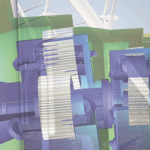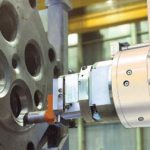Bolted joints are one of the most common elements in construction and design, and yet they are frequently the root cause of expensive structural failures. For an industry as young and exciting as wind energy joint failures can mean not only the loss of several million dollars, but also a severe dent in its quest to achieve wider acceptance as a reliable and attractive source of energy.
Breakthrough innovations developed by Load Control Technologies (LCT) have been addressing these concerns in the industry. Conventionally, when engineers designed bolted joints they designed to load or clamping force, but thereafter assembly and inspection was purely guesswork based on torque measurement. The i-Bolt® ultrasonic fastener technology developed by LCT clears all these ambiguities. The technology allows precise direct measurement of load in fasteners. This is seen to be immensely useful for controlling the tightening process in production and subsequent inspection measurements, all with load accuracies 10 times better than conventional techniques. The end result is that engineers are now equipped to not only design to load, but also to assemble and inspect to load, with absolute confidence in accuracy.
Understanding Joint Failure
Most joint failures are not due to joint design or the fastener selection. More often they are the result of insufficient or inconsistent clamp load at assembly. Problems such as bolt fatigue or vibration loosening, which account for over 75 percent of all bolted joint failures, can usually be prevented by achieving and maintaining a correct level of clamp load in the joint. A variation in installed fastener clamp load of 30 percent is typical with tightening control methods based on the measurement of applied torque. With the i-Bolt technology end users are able to tighten fasteners directly to load with ± 3 percent typical accuracy using any kind of tool, including high speed impulse and impact wrenches. All assembly torque, yield, and friction issues are completely eliminated. At any time after assembly and during the life of the joint, the operator will also be able to inspect the residual load in each joint in less than two seconds with ± 5 percent and without disturbing the joint. The i-Bolt technology is already proven in other industries and has been adopted by companies like Boeing, Airbus, John Deere, and GM after extensively validating the technology and its benefits (Figure 1).
The i-Bolt technology takes the end users’ fasteners and places a permanent ultrasonic transducer (only 50 microns thick) at the top or the bottom of each bolt. The transducer comprises of two layer: piezoelectric layer, which is the active element, and a metal electrode. Each transducer also has a 2D bar code laser etched on the surface, providing each fastener with unique traceability and a link to a database of assembly and inspection history. At no time during these processes is the form, fit, or function of these fasteners affected or changed. For load measurement an electrical pulse is applied to the transducer, which produces an acoustic wave that travels the length of the fastener and is reflected off the end and back to the transducer. The fastener elongates and the speed of this ultrasonic wave reduces with load, and the increase in time of flight of the acoustic wave provides an accurate measurement of load.
Unlike conventional ultrasonics, this technology doesn’t require parallel surfaces and is not dependant on transducer attachment procedures. Each bolt type and joint is first ultrasonically qualified by LCT, which replicates the end user’s joint, generates the ultrasonic parameters, and stores the ultrasonic signatures (including the zero load reading) of each individual bolt against their respective unique IDs in the transducer embedded 2D barcode. Once a joint/bolt type is qualified, it is so for the life of it. Bolts can be ordered indefinitely thereafter. The i-Bolts are ready to be used right away when the end users receive them. Moreover, the transducer is permanent and enables load inspections throughout the life of the joint at any time with near perfect repeatability and an accuracy of better than ±5 percent independent of the operator. Figure 2
Seamless Connectivity
The i-Bolts also work seamlessly with assembly tools. All existing hand and powered production assembly tools, including low-cost impulse and impact tools, are easily adapted for precise load control. These tools are equipped with a single, inexpensive, spring-loaded contact pin in their respective drives. The LoadMaster® ultrasonic control electronics are connected to the tool or incorporated inside the housing of the tool itself. These electronics generate the transducer excitation pulse-echo time of flight measurements and translate them into precise load readings. Load readings are then read by the assembly tool controller as the fastener is being tightened. The tool controller now monitors and stops on the required load (instead of torque) with a 3 percent accuracy.
These tightening and inspection data are digitally recorded. During routine inspection, the fastener is identified through the 2D bar code. LoadMaster electronics retrieve the zero-load acoustic signature and zero-load reading. The load measurement is then displayed onscreen and is automatically data logged in a maintenance database using a wireless link or directly to a PC using USB or Bluetooth as a permanent record of assembly and inspection history or in the form of excel spreadsheets for analysis. Figure 3
Importantly, the technology allows inspection on a fastener to be completed in two seconds. To inspect 10 percent of all the bolts on a wind tower, it typically takes over six hours with two men working in tandem. If one bolt fails they test all the bolts in that particular wind tower, which amounts to over 120 man hours. Using i-Bolt technology, such a routine inspection of 10 percent of bolts can be completed by a single man in 30 minutes. These savings are in additional to assembly cost reductions during installation from the reduction in the number torquing operations.
With these breakthrough capabilities the technology has seen application and acceptance in petrochemical, aeronautical, construction, automotive, as well as other fastener-intensive industries. With the minimal capital investment required in manufacturing equipment, and with products that can be immensely cost saving, the technology has excited market leaders in all these industries. It is at an exciting point in the wind industry, with companies now adopting the technology.
Summary
In conclusion, the technology is a big stride in quality assurance and preventive maintenance, as the end users can now measure load in the actual joint (without affecting it or changing it) to determine the installed loads achieved with their current tightening process. In addition, it provides traceability for each bolt. There is also the option for continuous load monitoring and the capability for real time field testing. Design engineers now have the potential of using smaller or fewer fasteners by tightening directly to load with i-Bolt. The ± 3 percent assembly accuracy allows them to utilize of the full strength of the fastener and verify they are achieving and maintaining that load in their joint designs throughout the life of the equipment.








































